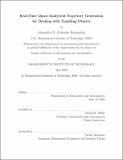Real-time quasi-analytical trajectory generation for docking with tumbling objects
Author(s)
Cabrales Hernandez, Alejandro D.
Download1191819275-MIT.pdf (9.612Mb)
Other Contributors
Massachusetts Institute of Technology. Department of Aeronautics and Astronautics.
Advisor
David W. Miller.
Terms of use
Metadata
Show full item recordAbstract
The capability to rendezvous and dock with tumbling objects has become prominent with increased interest in active debris removal, satellite servicing, and in-space assembly. Guidance and control algorithms have been developed in the literature to allow for a spacecraft to capture an uncooperative and tumbling object under several constraints such as collision avoidance, speed bounds, and thruster saturation. However, current algorithms for this capability do not address plume impingement due to thrusters, which can lead to damage to the target object, and can require the use of nonlinear solvers that neither guarantee convergence of a solution nor be deployed in real-time using current computational capabilities of spacecraft. This thesis presents a quasi-analytical guidance algorithm that allows for a spacecraft to soft-dock with a target, avoids plume impingement, and allows for real-time generation of trajectories with low computational expense. Several test cases compare the solution from this algorithm against a solution using pseudospectral methods and show similar performance at less than 0.1% computational cost, and an example scenario for docking with the the European Space Agency's ENVISAT is presented. Additionally, a discrete transport trajectory optimizer is presented for use as a first cut solution to transporting several components to the same halo orbit for in-space assembly.
Description
Thesis: S.M., Massachusetts Institute of Technology, Department of Aeronautics and Astronautics, May, 2020 Cataloged from the official PDF of thesis. Includes bibliographical references (pages 153-157).
Date issued
2020Department
Massachusetts Institute of Technology. Department of Aeronautics and AstronauticsPublisher
Massachusetts Institute of Technology
Keywords
Aeronautics and Astronautics.